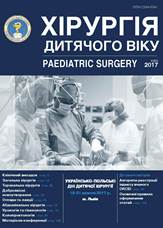Using of propranolol in conservative treatment of haemangiomas in infants
DOI:
https://doi.org/10.15574/PS.2017.57.35Keywords:
haemangioma, propranolol, conservative treatment, childrenAbstract
Haemangiomas are the most common benign tumours in infancy starting from an early age and can appear as minor cosmetic defects that sometimes spontaneously decrease, or can cause serious functional disorders or even threaten life. As of today the choice of treatment strategy remains controversial. Accidental discovery of positive treatment effect in the conservative treatment of haemangioma by using propranolol gave hope for effective conservative treatment already at an early stage.Objective. To analyze the effectiveness of haemangioma therapy in infants using nonselective β-blockers (propranolol).
Methods. Propranolol therapy was used in 92 patients (69 girls, 23 boys) with haemangiomas of various sizes, quantity and localization aged 2 to 11 months (87 children) and 15-19 months (5 children). The treatment was performed from April 2010 to May 2017. In most patients haemangiomas were located on the head and neck (59 children, 63.9%). In 1 case (1.1%) diffuse infantile haemangioendotelioma of liver was diagnosed. All patients received propranolol at a dose of 2-3 mg/kg/day. End of treatment occurred after the proliferation phase and after obtaining a positive clinical and radiological response.
Results. Positive clinical response occurred in 86 patients (93.5%) resulting in a phase of proliferation and subsequent reduction of tumour. At the majority of patients from the very first days of treatment, response was noted in changes of skin colour (pale), reducing the volume and intensity. Therapy was completed in 68 patients (73.9%), duration of treatment is 2-12 months. In 3 cases removal of the drug after 3-5 months of treatment led to the recurrence. After 1-2 months pause in treatment, therapy was restored and positive response was received. Any disorders of the cardiovascular system or glycaemic indexes were not revealed. There were no clinically significant adverse effects that caused discontinuation of treatment.
Conclusions. Early assessment of treatment using nonselective β-blockers (propranolol) indicates its high efficiency simultaneously with good tolerance. Further study has to focus on patient’s age limit for administration of treatment, the criteria for the end of treatment, duration of therapeutic effect, efficiency of propranolol in cases of recurrence.
Downloads
Issue
Section
License
The policy of the Journal “PAEDIATRIC SURGERY. UKRAINE” is compatible with the vast majority of funders' of open access and self-archiving policies. The journal provides immediate open access route being convinced that everyone – not only scientists - can benefit from research results, and publishes articles exclusively under open access distribution, with a Creative Commons Attribution-Noncommercial 4.0 international license(СС BY-NC).
Authors transfer the copyright to the Journal “PAEDIATRIC SURGERY.UKRAINE” when the manuscript is accepted for publication. Authors declare that this manuscript has not been published nor is under simultaneous consideration for publication elsewhere. After publication, the articles become freely available on-line to the public.
Readers have the right to use, distribute, and reproduce articles in any medium, provided the articles and the journal are properly cited.
The use of published materials for commercial purposes is strongly prohibited.

